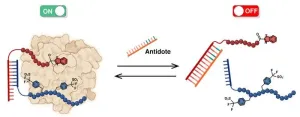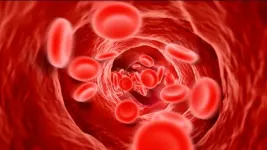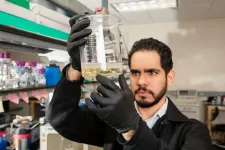(Press-News.org) Millions of working parents know the routine: bustle the kids off to childcare in the morning, work all day, then fight the daily traffic jams to get the kids back home. Something to drink, maybe a snack to munch, can help ease the commute.
Understandably, few parents take the time to think about the nutrients or calories involved, but experts at Cincinnati Children’s decided to take a closer look. Their eyebrow-raising findings were published April 27, 2024, in the journal Children’s Health Care.
The researchers took a fresh look at older data contained in daily food journals kept by more than 300 families of children who attended 30 childcare centers that participated in the Preschool Eating and Activity Study (2009-2011). They found that the hour after parents and caregivers picked up their children stood out as a high-calorie, relatively less healthy part of the child’s overall diet.
Overall, these children, ages 3 to 5, consumed more than 1,471 calories across the entire day—an amount on the high end of recommended daily limits. Of that amount, 290 calories, on average, were consumed in the hour after leaving day care. That’s about 20% of the day’s entire calorie intake.
Adding concern: after-care food and drink accounted for about 22% of the day’s added sugar and about one-third of the sweet and salty snack foods the children ate.
“Every parent knows how busy that time of day can feel. Parents can feel stressed, the kids may be cranky, hungry, or tired. There’s nothing wrong with treats once in a while,” says senior author Kristen Copeland, MD, Division of General and Community Pediatrics. “But that car ride home also can be an opportunity to instill healthier habits instead of less healthy ones.”
If busy parents want to try a small change that might make a big difference, consider stocking the car with veggie sticks, cheese, fruit slices, and low-sugar drinks such as water or milk. A few minutes of preparation can make it easier to skip the high-calorie drive-throughs and sugar-loaded packaged snacks.
“Children of preschool age are in a highly habit-forming time of their lives. They thrive on routine,” Copeland says. “Children often look forward to the car ride home, which makes that time an opportunity to start a healthy snacking habit that could last a lifetime.”
About the study
The study’s lead author was Kelsey Egan, MD, MSc, Boston University. Cincinnati Children’s co-authors included Allison Parsons, PhD, (now working in San Diego), Nicholas Ollberding, PhD, and Laurie A. Smith, MS.
Funding sources included the National Institutes of Health (K23 HL088053), the Robert Wood Johnson Foundation’s Physicians Faculty Scholars program, and the Health Research Services Administration (T32HP10027). The content of the study is solely the responsibility of the authors and does not necessarily represent the official views of The National Institutes of Health, the Health Research Services Administration, or any other funders.
Millions of working parents know the routine: bustle the kids off to childcare in the morning, work all day, then fight the daily traffic jams to get the kids back home. Something to drink, maybe a snack to munch, can help ease the commute.
Understandably, few parents take the time to think about the nutrients or calories involved, but experts at Cincinnati Children’s decided to take a closer look. Their eyebrow-raising findings were published April 27, 2024, in the journal Children’s Health Care.
The researchers took a fresh look at older data contained in daily food journals kept by more than 300 families of children who attended 30 childcare centers that participated in the Preschool Eating and Activity Study (2009-2011). They found that the hour after parents and caregivers picked up their children stood out as a high-calorie, relatively less healthy part of the child’s overall diet.
Overall, these children, ages 3 to 5, consumed more than 1,471 calories across the entire day—an amount on the high end of recommended daily limits. Of that amount, 290 calories, on average, were consumed in the hour after leaving day care. That’s about 20% of the day’s entire calorie intake.
Adding concern: after-care food and drink accounted for about 22% of the day’s added sugar and about one-third of the sweet and salty snack foods the children ate.
“Every parent knows how busy that time of day can feel. Parents can feel stressed, the kids may be cranky, hungry, or tired. There’s nothing wrong with treats once in a while,” says senior author Kristen Copeland, MD, Division of General and Community Pediatrics. “But that car ride home also can be an opportunity to instill healthier habits instead of less healthy ones.”
If busy parents want to try a small change that might make a big difference, consider stocking the car with veggie sticks, cheese, fruit slices, and low-sugar drinks such as water or milk. A few minutes of preparation can make it easier to skip the high-calorie drive-throughs and sugar-loaded packaged snacks.
“Children of preschool age are in a highly habit-forming time of their lives. They thrive on routine,” Copeland says. “Children often look forward to the car ride home, which makes that time an opportunity to start a healthy snacking habit that could last a lifetime.”
About the study
The study’s lead author was Kelsey Egan, MD, MSc, Boston University. Cincinnati Children’s co-authors included Allison Parsons, PhD, (now working in San Diego), Nicholas Ollberding, PhD, and Laurie A. Smith, MS.
Funding sources included the National Institutes of Health (K23 HL088053), the Robert Wood Johnson Foundation’s Physicians Faculty Scholars program, and the Health Research Services Administration (T32HP10027). The content of the study is solely the responsibility of the authors and does not necessarily represent the official views of The National Institutes of Health, the Health Research Services Administration, or any other funders.
END
Childcare pick-up: a 1-hour window to build healthier eating habits
Experts at Cincinnati Children’s find excess calories, added sugar and salt in treats given to children on the way home
2024-04-30
ELSE PRESS RELEASES FROM THIS DATE:
MD Anderson and Replay announce FDA clearance of IND application for first-in-class PRAME-targeted TCR NK cell therapy for hematological malignancies
2024-04-30
HOUSTON, SAN DIEGO and LONDON ― The University of Texas MD Anderson Cancer Center and Replay today announced that the Food & Drug Administration (FDA) has issued a ‘safe to proceed’ for the Investigational New Drug (IND) application for PRAME TCR/IL-15 NK (SY-307), an engineered T cell receptor natural killer (TCR NK) cell therapy for relapsed/refractory myeloid malignancies. MD Anderson is the IND sponsor.
PRAME TCR/IL-15 NK (SY-307) is being developed by Syena, an oncology-focused product company launched by Replay and MD Anderson based on the scientific discoveries of Katy ...
Discovery of mechanism plants use to change seed oil could impact industrial, food oils
2024-04-30
PULLMAN, Wash. -- Researchers have discovered a new mechanism of oil biosynthesis and found a way to genetically engineer a type of test plant to more efficiently produce different kinds of seed oil that it otherwise wouldn't make.
While the engineering is proof-of-concept, this discovery could lead to improved production of valuable oils used in food and by a range of industries. The study, led by Washington State University researchers, was published in the journal Nature Communications.
“Scientists have been working on producing ...
A new anticoagulant with no risk of bleeding
2024-04-30
Anticoagulant treatments are crucial for managing many conditions, such as heart disease, stroke and venous thrombosis. Current options, however, carry an inherent risk of serious bleeding due to trauma or unforeseen events. A team from the University of Geneva (UNIGE) and the University of Sydney has developed a new anticoagulant, designed to have an on-demand reversible activity, with a fast-acting ‘‘antidote’’. This approach could revolutionise the use of anticoagulants in surgery or other applications. The mechanism of activation and deactivation of the active principle ...
Genetic adaptations have impacted the blood compositions of two populations from Papua New Guinea
2024-04-30
Papua New Guinea (PNG) has a wide range of environments, each presenting unique challenges to human survival. Highlanders and lowlanders of PNG are striking examples of populations facing distinct environmental stress. Whereas the highlanders encounter low oxygen availability due to altitude, the lowlanders are exposed to specific pathogens that are absent in the highlands, such as malaria. Despite these strong environmental pressures, the specific adaptations of these populations have remained overlooked. A new study published in Nature Communications on Tuesday, 30 April 2024 sheds light on the genetic adaptations of Papua New Guineans in response to their unique environmental ...
Abrupt permafrost thaw intensifies warming effects on soil CO2 emission
2024-04-30
According to a recent study published in Nature Geoscience, scientists have found that soil carbon dioxide (CO2) emissions are more sensitive to climate warming in permafrost-collapsed areas than in non-collapsed areas.
This study, based on field warming experiments combined with laboratory incubation of soils from a large-scale sampling, provides new insights about permafrost carbon–climate feedback in the context of future climate warming.
Warmer temperatures have led to rapid permafrost thawing in high-latitude and -altitude permafrost regions. Abrupt permafrost thaw, ...
Scientists discover over 100 new genomic regions linked to blood pressure
2024-04-30
National Institutes of Health researchers and collaborators have discovered over 100 new regions of the human genome, also known as genomic loci, that appear to influence a person’s blood pressure. Results of the study also point to several specific genomic loci that may be relevant to iron metabolism and a type of cellular receptor known as adrenergic receptors.
The study, published in Nature Genetics, is one of the largest such genomic studies of blood pressure to date, including data from over 1 ...
Researchers identify over 2,000 genetic signals linked to blood pressure in study of over one million people
2024-04-30
The Queen Mary-led study reveals the most detailed picture yet of genetic contributors to blood pressure. The findings lead to improved polygenic risk scores, which will better predict blood pressure and risk for hypertension.
Researchers led by Queen Mary University of London and supported by the National Institute for Health and Care Research (NIHR) have discovered over a hundred new regions of the human genome, also known as genomic loci, that appear to influence a person’s blood pressure. In total, over 2,000 independent genetic signals for blood pressure are now reported, demonstrating that blood pressure is a highly complex trait influenced by thousands ...
Scientists find cancer-like features in atherosclerosis, spurring opportunity for new treatment approaches
2024-04-30
Researchers have discovered that the smooth muscle cells that line the arteries of people with atherosclerosis can change into new cell types and develop traits similar to cancer that worsen the disease. Atherosclerosis is characterized by a narrowing of arterial walls and can increase risk of coronary artery disease, stroke, peripheral artery disease, or kidney disorders. The findings, supported by the National Institutes of Health (NIH), could pave the way for the use of anti-cancer drugs to counteract the tumor-like mechanisms ...
A virus could help save billions of gallons of wastewater produced by fracking
2024-04-30
EL PASO, Texas (April 30, 2024) – An estimated 168 billion gallons of wastewater — or produced water — is generated annually by the Permian Basin fracking industry, according to a 2022 report by the Texas Produced Water Consortium. The major waste stream has proved both difficult and costly to treat because of the chemical complexity of the water.
In a new study published in the journal Water, researchers at The University of Texas at El Paso have identified a novel means of treating the wastewater generated by oil and gas production: bacteriophages.
Ramón Antonio Sánchez, a doctoral candidate within UTEP’s chemistry ...
MSD joins the Open Targets consortium
2024-04-30
Open Targets, a public-private partnership dedicated to pre-competitive drug discovery research, today announced MSD, the tradename of Merck & Co., Inc., Rahway, N.J., USA, as the latest partner to join the consortium. Open Targets aims to accelerate the development of safe and effective medicines by leveraging cutting-edge technologies to identify, prioritise, and validate potential drug targets. MSD’s expertise in drug discovery will complement the strengths of the current partners: EMBL’s European Bioinformatics Institute (EMBL-EBI), the Wellcome Sanger Institute, GSK, Sanofi, Pfizer, and Genentech, ...
LAST 30 PRESS RELEASES:
Next-generation vision model maps tree growth at sub-meter precision
Genes aren’t destiny for inherited blindness, study shows
MIT study: High-fat diets make liver cells more likely to become cancerous
Exposure to multiple fine particulate matter components and incident depression in the US Medicare population
Risk of burdensome health care spending over time in the US
Nirsevimab against hospitalizations and emergency department visits for lower respiratory tract infection in infants
New microfluidics technology enables highly uniform DNA condensate formation
A new strategy for immune tolerance
Super Mario Bros. help fight burnout: New study links classic games to boosted happiness
Deepest gas hydrate cold seep ever discovered in the arctic: International research team unveils Freya Hydrate Mounds at 3,640 m depth.
Integrating light and structure: Smarter mapping for fragile wetland ecosystems
ACA-SIM: A robust way to decode satellite signals over complex waters
Probiotics can restore gut microbiome in breastfed infants
AI could help predict nutrition risks in ICU patients, study finds
Federal EITC has unexpected result, researchers say – it decreases domestic violence
Researchers identify gene that calms the mind and improves attention in mice
Artificial metabolism turns waste CO2 into useful chemicals
Ancient sea anemone sheds light on animal cell type evolution
Begging gene leads to drone food
How climate policies that incentivize and penalize can drive the clean energy transition
Can community awareness campaigns in low-resource areas improve early diagnosis of colorectal cancer?
Stardust study resets how life’s atoms spread through space
Practical education: Clinical scenario-based program development
The impact of family dynamics on eating behaviour – how going home for Christmas can change how you eat
Tracing the quick synthesis of an industrially important catalyst
New software sheds light on cancer’s hidden genetic networks
UT Health San Antonio awarded $3 million in CPRIT grants to bolster cancer research and prevention efforts in South Texas
Third symposium spotlights global challenge of new contaminants in China’s fight against pollution
From straw to soil harmony: International team reveals how biochar supercharges carbon-smart farming
Myeloma: How AI is redrawing the map of cancer care
[Press-News.org] Childcare pick-up: a 1-hour window to build healthier eating habitsExperts at Cincinnati Children’s find excess calories, added sugar and salt in treats given to children on the way home





